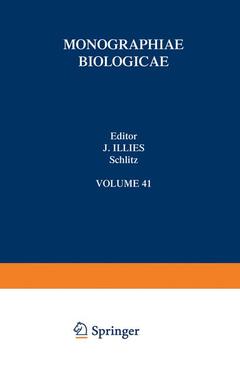Description
Ecological Biogeography of Australia, 1981
Coll. Monographiae Biologicae, Vol. 41
Coordinator: Keast A.
Language: French
Subject for Ecological Biogeography of Australia:
Publication date: 08-2014
2142 p. · 15.5x23.5 cm · Paperback
2142 p. · 15.5x23.5 cm · Paperback
Description
/li>Contents
/li>
Understanding the biogeography of Australia requires knowledge of both existing and former environments. The existing environment is discussed elsewhere in the volume but a few salient points should be reiterated. Three-quarters of Australia is either arid or semi-arid and even much of the better-watered fringes has long dry seasons. Vast stretches of ocean separate it from other land masses except in the north where New Guinea and Indonesia form 'stepping stones' to and from Asia. It is also a low continent with over 99% of its area below 1000 m; even the highest summits barely exceed 2000 m. Since most of the surface has undergone prolonged weath ering, poor soils are the rule. The impact of man on the landscape has been less than in more densely settled continents. Aboriginal man has inhabited the continent for 40,000 years or more but agriculture and stock rearing have operated for less than two centuries and the present rural population is sparse. Large parts of the dry interior are not occupied although they are affected to some extent by introduced feral animals.
one: The development of the Australian environment.- 1. The break-up of the Australian-Antarctic segment of Gondwanaland.- 2. The Early Cretaceous break-up of Eastern Gondwanaland, the separation of Australia and India, and their interaction with Southeast Asia.- 3. Tertiary palaeogeography and the evolution of Australian climate.- 4. Late Cainozoic environments in Australia.- 5. Quaternary vegetation and environments.- 6. The environment of Terra Australis.- 7. Fire and the evolution of the Australian biota.- two: The flora of Australia.- 8. Major vegetation formations in Australia.- 9. Ecophysiological principles determining the biogeography of major vegetation formations in Australia.- 10. The history of the phytogeographic region concept in Australia.- 11. The Cretaceous flora.- 12. Tertiary megafossil floras of Australia as indicators of floristic associations and palaeoclimate.- 13. The Tertiary flora.- 14. Origins of the Australian angiosperm flora.- 15. Three old southern families — Myreaceae, Proteaceae and Restionaceae.- 16. Ecological biogeography of Australian conifers and ferns.- 17. Eucalyptus, the universal Australian.- 18. The biogeography of Australian grasses.- 19. The loranthaceous mistletoes in Australia.- 20. Biogeography of halophytic angiosperms (salt-marsh, mangrove and sea-grass).- 21. Lichens.- 22. Australian rainforests: Patterns and change.- 23. The vegetation of the arid zone.- 24. Vegetation of high mountains in Australia.- 25. Phytogeography of southern Australia.- 26. Cytoevolutionary patterns, genetic systems and the phytogeography of Australia.- 27. Evolution of the Australian flora: Some generalizations.- three: The terrestrial invertebrates of Australia.- 28. Australian spiders: Diversity, distribution and ecology.- 29. Eco-evolutionary radiation of Mygalomorph spiders in Australia.- 30. The Scorpions of Australia: Aspects of their ecology and zoogeography.- 31. Historical biogeography of Australian Oligochaeta.- 32. The biogeography and evolution of Australian land snails.- 33. The origin of Lepidoptera relative to Australia.- 34. The geography of the Australian Papilionoidea.- 35. Zoogeography of some Australian Coleoptera as exemplified by the Scarabaeoidea.- 36. Australian Drosophila: Diversity, resource utilization and radiations.- 37. A comparative account of the biogeography of terrestrial invertebrates in Australia: Some generalizations.- four: Biogeography of inland fresh waters.- 38. Inland aquatic systems: An overview.- 39. The Crustacea of Australian inland waters.- 40. Odonata (dragonflies and damselflies).- 41. Plecoptera.- 42. Blephariceridae.- 43. Aquatic and semi-aquatic bugs (Hemiptera) of Australia.- 44. Aquatic insects: An overview.- 45. The distribution of freshwater mussels (Mollusca: Pelecypoda) in the Australian zoogeographic region.- 46. The relationships of Australian freshwater fishes.- five: Biogeography of poikilothermic vertebrates.- 47. The Amphibia: Diversity and distribution.- 48. The Amphibia of mesic Southern Australia: A zoogeographic perspective.- 49. The Australian reptiles: Origins, biogeography, distribution patterns and island evolution.- 50. Diversity and adaptive radiations of Australian desert lizards.- 51. Ecophysiology of Australian desert lizards: Studies on the genus Amphibolurus.- six: Biogeography of homeothermic vertebrates.- 52 A review of the origins and radiations of Australian mammals.- 53 Adaptation of macropod marsupials to aridity.- 54 Rodents — The late invaders.- 55 The biogeography of Australian bats.- 56 The evolutionary biogeography of Australian birds.- 57 Nectar-feeding and its evolution among Australian vertebrates.- 58 Adjustments of Australian birds to thermal conditions and water scarcity in arid zones.- 59 Species densities of Australian vertebrates.- 60 Cape York Peninsula: Major region of faunal interchange.- seven: Origins and ecology of aboriginal man.- 61 The aborigines: An introduction.- 62 The arrival and adaptation of Australian aborigines.- 63 Prehistory of the Aborigines: Some interesting considerations.- 64 Physiological, demographic and genetic adaptation of Australian Aboriginals.- 65 Hunter-gatherers in a rich environment: Aboriginal coastal exploitation in Cape York peninsula.- 66 Desert aborigines and the southern coastal peoples: Some comparisons.- 67 Integration: Some afterthoughts.- eight: Integration.- 68 Distributional patterns, regional biotas, and adaptations in the Australian biota: A synthesis.- 69 Origins and relationships of the Australian biota.- Systematic index.
© 2024 LAVOISIER S.A.S.

